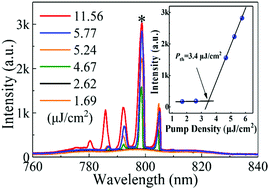Femtosecond laser direct writing of perovskite patterns with whispering gallery mode lasing†
Abstract
Hybrid perovskites have recently attracted attention in both materials science and opto-electronics research, because of their excellent opto-electronic properties and facile fabrication. Perovskite-based photovoltaic devices, photodetectors, and light-emitting diodes have exhibited unprecedented success. Moreover, optically pumped perovskite lasers have been reported with various crystal shapes. However, most of these lasers are fabricated from solution-grown micro/nano crystals, and thus lack reproducibility. Here, we present controllable fabrication of formamidinium lead iodide (FAPbI3) perovskite microdisks by thermal co-evaporation, coupled with femtosecond laser direct writing. After careful investigation of dimensional effects, including the impact of diameter and thickness, we achieved an ultra-low threshold of ∼3 μJ cm−2. Furthermore, we investigated the relationship of lasing performance with carrier dynamics by transient absorption. We found that a longer carrier lifetime can reduce the pump threshold. These microdisk lasers based on femtosecond laser fabrication of evaporated perovskite thin films show exceptional reproducibility, rendering them extremely suitable for mass production; hence, they offer a promising method for low-cost, on-chip coherent light sources.



 Please wait while we load your content...
Please wait while we load your content...